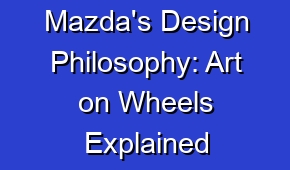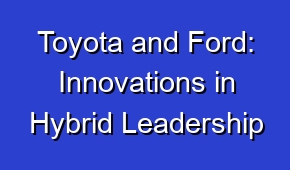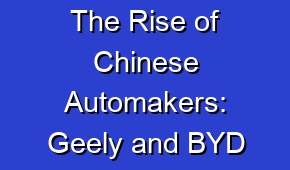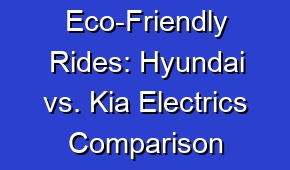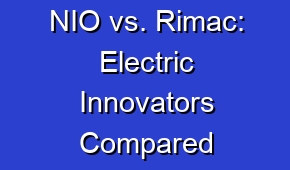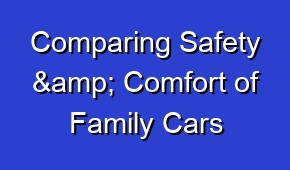Volkswagen’s Journey: Decades of Innovation and Success
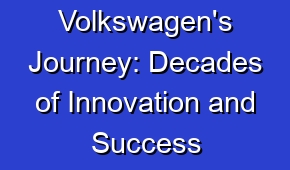
Discover the fascinating journey of Volkswagen through the decades as this iconic automaker has continuously evolved and adapted to the changing times. From its humble beginnings to becoming a global powerhouse, explore the milestones, innovations, and timeless designs that have shaped Volkswagen’s rich history.
Volkswagen’s journey through the decades has been a remarkable evolution of innovation and success. From its humble beginnings in 1937, the German automaker has revolutionized the industry with iconic models such as the Beetle and the Golf. Throughout the years, Volkswagen has adapted to changing market trends and customer demands, constantly improving its vehicles’ performance, design, and technology. The brand’s commitment to sustainability has also played a crucial role in shaping its journey, as Volkswagen strives to develop more environmentally friendly cars. With each passing decade, Volkswagen has embraced new challenges and opportunities, establishing itself as a global leader in the automotive industry. Today, the company continues to innovate and push boundaries, paving the way for a future where electric and autonomous vehicles will dominate the roads.
| Volkswagen’s journey through the decades showcases its evolution and innovation in the automotive industry. |
| The iconic Volkswagen Beetle became a symbol of the 1960s counterculture movement. |
| Volkswagen introduced the Golf GTI, a popular and influential hot hatch, in the 1970s. |
| The 1980s saw Volkswagen’s expansion into luxury cars with the introduction of the Passat. |
| In the 1990s, Volkswagen launched the New Beetle, a modern reinterpretation of the classic model. |
- The 2000s marked Volkswagen’s shift towards sustainability with the introduction of hybrid and electric vehicles.
- Volkswagen faced a major scandal in 2015 due to the diesel emissions cheating scandal.
- In recent years, Volkswagen has focused on developing autonomous driving technology and connected cars.
- The company plans to launch a lineup of fully electric vehicles under its ID series.
- Volkswagen aims to become carbon neutral by 2050 through various sustainability initiatives.
The Evolution of Volkswagen: How has the brand transformed over the decades?
Volkswagen’s journey through the decades is a fascinating story of innovation, growth, and adaptation. From its humble beginnings in Germany in the 1930s to becoming one of the world’s leading automobile manufacturers, Volkswagen has undergone significant transformations.
| Decade | Transformation | Key Features |
| 1930s | Foundation and early development | Introduction of the iconic Beetle |
| 1960s | Expansion and globalization | Launch of the Volkswagen Type 2 (VW Bus) |
| 1990s | Modernization and diversification | Introduction of the Golf and Polo models |
In the early years, Volkswagen introduced iconic models such as the Beetle, which quickly gained popularity for its affordability and reliability. The Beetle became a symbol of the brand and played a crucial role in Volkswagen’s success.
What are some iconic Volkswagen models that have shaped the brand’s history?
Volkswagen’s journey through the decades is marked by several iconic models that have left a lasting impact on the automotive industry. One such model is the Volkswagen Beetle, which was introduced in the 1930s and became synonymous with the brand. Its unique design and affordability made it a beloved car around the world.
- Volkswagen Beetle
- Volkswagen Golf
- Volkswagen Bus
Another iconic model is the Volkswagen Golf, which was first introduced in 1974. The Golf revolutionized the compact car segment with its innovative features, sporty performance, and versatile design. It quickly gained popularity and became one of Volkswagen’s best-selling models.
How has Volkswagen’s design philosophy evolved over time?
Volkswagen’s journey through the decades has been marked by a continuous evolution of its design philosophy. In the early years, Volkswagen focused on creating simple, functional, and timeless designs. The Beetle, with its iconic rounded shape and minimalistic features, exemplified this philosophy.
- Volkswagen’s design philosophy in the early years focused on creating affordable and practical cars for the masses.
- In the 1960s and 1970s, Volkswagen embraced a more iconic and recognizable design language with the introduction of the Beetle and the Type 2 van.
- In the 1990s, Volkswagen started to prioritize a more sleek and modern design, seen in models like the Golf and Passat.
- By the 2000s, Volkswagen adopted a more aggressive and sporty design philosophy, evident in models like the GTI and the Scirocco.
- In recent years, Volkswagen has shifted towards a more sustainable and futuristic design approach, with an emphasis on electric vehicles and clean lines.
As the brand expanded its product range, Volkswagen started incorporating more modern and dynamic design elements into its vehicles. The Golf, for example, introduced a more aerodynamic profile and sleek lines that enhanced its sporty appeal.
What are some of the technological innovations introduced by Volkswagen over the years?
Volkswagen’s journey through the decades has been marked by numerous technological innovations that have pushed the boundaries of automotive engineering. One significant innovation was the introduction of fuel injection systems in the 1960s, which improved engine performance and fuel efficiency.
| Technology | Year Introduced | Description |
| DSG (Direct Shift Gearbox) | 2003 | An automated dual-clutch transmission system that provides smooth and quick gear shifts. |
| App Connect | 2015 | A feature that allows seamless integration of smartphones with the car’s infotainment system, providing access to apps and features. |
| Virtual Cockpit | 2016 | A digital instrument cluster that replaces traditional analog dials with customizable high-resolution screens. |
In the 1980s, Volkswagen introduced the first generation of its electronic fuel injection system, known as Digifant. This system improved engine control and optimized fuel delivery, leading to better overall performance.
How has Volkswagen contributed to environmental sustainability?
Volkswagen’s journey through the decades has seen the brand take significant steps towards environmental sustainability. In recent years, Volkswagen has made a commitment to electrification and reducing its carbon footprint.
Volkswagen has contributed to environmental sustainability through initiatives like electric vehicle production, renewable energy use, and carbon emissions reduction.
The brand’s electric vehicle lineup, including models like the ID.3 and ID.4, represents Volkswagen’s efforts to transition towards cleaner mobility solutions. These vehicles produce zero tailpipe emissions and contribute to reducing air pollution.
What are some of the challenges Volkswagen has faced throughout its history?
Volkswagen’s journey through the decades has not been without challenges. One significant challenge was the impact of World War II on the brand’s operations. The war disrupted production and caused significant damage to Volkswagen’s facilities.
Volkswagen has faced challenges such as the diesel emissions scandal, competition in the global market, and managing its vast supply chain.
In more recent years, Volkswagen faced a major setback with the diesel emissions scandal in 2015. The scandal involved the manipulation of emissions tests, which resulted in a loss of trust and reputation for the brand. Volkswagen has since taken steps to address the issue, including recalling affected vehicles and implementing stricter emission standards.
How has Volkswagen’s marketing strategy evolved over time?
Volkswagen’s journey through the decades is not only about its products but also about its marketing strategies. In the early years, Volkswagen focused on promoting the affordability and reliability of its vehicles through simple yet effective advertising campaigns.
Focus on Reliability and Affordability
In its early years, Volkswagen positioned itself as a reliable and affordable option in the automotive market. The company’s marketing strategy focused on highlighting the durability and practicality of its vehicles, targeting middle-class consumers who were looking for reliable transportation at an affordable price point.
Over time, Volkswagen expanded its product line and introduced new models to cater to different market segments. However, the core message of reliability and affordability remained a key component of the company’s marketing strategy.
Embracing Innovation and Technology
As technology advanced and consumer preferences shifted, Volkswagen adapted its marketing strategy to emphasize innovation and technological advancements in its vehicles. The company started incorporating features such as advanced safety systems, touchscreen infotainment systems, and hybrid or electric powertrains into its models.
Volkswagen’s marketing campaigns began highlighting these technological advancements, positioning the brand as forward-thinking and appealing to tech-savvy consumers. The company also invested in digital marketing channels and utilized social media platforms to reach a wider audience and showcase its technological innovations.
Environmental Sustainability and Electric Mobility
In recent years, Volkswagen has made a significant shift towards promoting environmental sustainability and electric mobility. This change in marketing strategy is in response to growing concerns about climate change and the need for cleaner transportation options.
Volkswagen has launched several electric vehicle models, such as the ID.3 and ID.4, and has heavily marketed these vehicles as eco-friendly alternatives to traditional gasoline-powered cars. The company’s marketing campaigns now focus on the benefits of electric mobility, such as reduced carbon emissions and lower fuel costs.
Volkswagen’s commitment to environmental sustainability is also reflected in its overall brand image and messaging. The company aims to position itself as a leader in the transition to electric mobility and has set ambitious targets for the electrification of its vehicle lineup.
One of the most notable marketing campaigns was the “Think Small” campaign in the 1960s, which embraced the compact size of the Beetle as an advantage. This campaign challenged traditional notions of car advertising and resonated with consumers.

